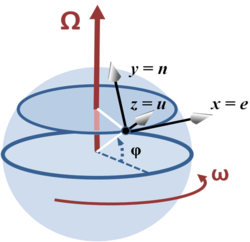User:John R. Brews/Coriolis force: Difference between revisions
imported>John R. Brews No edit summary |
imported>John R. Brews No edit summary |
||
| Line 32: | Line 32: | ||
<references/> | <references/> | ||
Contributed by myself in June 2008, for example, [http://en.wikipedia.org/w/index.php?title=Coriolis_effect&diff=218224145&oldid=218221895 here] [http://en.wikipedia.org/w/index.php?title=Coriolis_effect&diff=218199099&oldid=218197139 here] | Contributed by myself in June 2008, for example, [http://en.wikipedia.org/w/index.php?title=Coriolis_effect&diff=218224145&oldid=218221895 here] [http://en.wikipedia.org/w/index.php?title=Coriolis_effect&diff=218199099&oldid=218197139 here], [http://en.wikipedia.org/w/index.php?title=Coriolis_effect&diff=219110044&oldid=219105420 added Limerick] | ||
Revision as of 12:34, 5 March 2011
Rotating sphere
Consider a location with latitude φ on a sphere that is rotating around the north-south axis.[1] A local coordinate system is set up with the x axis horizontally due east, the y axis horizontally due north and the z axis vertically upwards. The rotation vector, velocity of movement and Coriolis acceleration expressed in this local coordinate system (listing components in the order East (e), North (n) and Upward (u)) are:
When considering atmospheric or oceanic dynamics, the vertical velocity is small and the vertical component of the Coriolis acceleration is small compared to gravity. For such cases, only the horizontal (East and North) components matter. The restriction of the above to the horizontal plane is (setting vu=0):
where is called the Coriolis parameter.
By setting vn = 0, it can be seen immediately that (for positive φ and ω) a movement due east results in an acceleration due south. Similarly, setting ve = 0, it is seen that a movement due north results in an acceleration due east. In general, observed horizontally, looking along the direction of the movement causing the acceleration, the acceleration always is turned 90° to the right and of the same size regardless of the horizontal orientation. That is:[2][3]
| ‘ | On a merry-go-round in the night Coriolis was shaken with fright |
’ |
—David Morin, Eric Zaslow, E'beth Haley, John Golden, and Nathan Salwen | ||
As a different case, consider equatorial motion setting φ = 0°. In this case, Ω is parallel to the North or n-axis, and:
Accordingly, an eastward motion (that is, in the same direction as the rotation of the sphere) provides an upward acceleration known as the Eötvös effect, and an upward motion produces an acceleration due west.
Notes
- ↑ William Menke & Dallas Abbott (1990). Geophysical Theory. Columbia University Press, 124–126. ISBN 0231067925.
- ↑ David Morin, Eric Zaslow, Elizabeth Haley, John Goldne, and Natan Salwen (2 December 2005). Limerick – May the Force Be With You. Weekly Newsletter Volume 22, No 47. Department of Physics and Astronomy, University of Canterbury. Retrieved on 2009-01-01.
- ↑ David Morin (2008). Introduction to classical mechanics: with problems and solutions. Cambridge University Press. ISBN 0521876222.
Contributed by myself in June 2008, for example, here here, added Limerick








